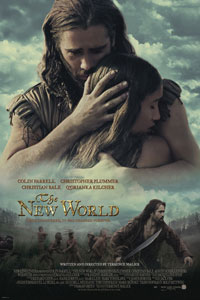The New World (PG-13) ★★★★
 Definitely not Disney’s Pocahontas, but you can still bring the whole family to this gorgeous historical epic, which boasts one of the most beautiful and moving big-screen romances in years.
Definitely not Disney’s Pocahontas, but you can still bring the whole family to this gorgeous historical epic, which boasts one of the most beautiful and moving big-screen romances in years.
Story
A fresh update on the Pocahontas legend. Captain John Smith (Colin Farrell) arrives in disgrace on the shores of the New World, but he is pardoned and soon rises to lead the English settlers of what will eventually be Jamestown, Virginia. Sent to trade with a local chief, Powhatan, he falls in love with his daughter, Pocahontas (Q'Orianka Kilcher). He follows his duty, rather than his heart, and returns to Jamestown, whose starving citizens would not have survived the harsh winter without Pocahontas’s help. Powhatan (Wes Studi) mounts an attack to force the settlers to leave, but Pocahontas warns Smith, leading to her banishment and her new life with the Europeans. Eventually, Smith is called away to mount his own expeditions, leaving Pocahontas behind with a heavy heart. She finds a new suitor, a gentleman farmer who wants to marry her, but she still pines for Smith. Her fame spreads far beyond the New World, back to England, where she is summoned to meet the king and queen.
Acting
Farrell is finally delivering on his early promise, momentarily setting aside noisy action films to work with a world-class director and reminding us just how subtle of an actor he can be. The amazing chemistry between Farrell and newcomer Kilcher puts nearly every other movie pairing this year to shame. Kilcher, who had one screen credit to her name before this, was only 14 during filming, quite close to Pocahontas’ believed age of 12 or 13. Before you reach for that picket sign, please note that while the romance is incredibly sensual, as is the whole film, nothing is shown other than longing looks and playful, platonic embraces. As Pocahontas, Kilcher radiates beauty and innocence and it’s easy to see why John Smith would be mesmerized by her. After Smith has left, her scenes of grief are heartfelt and her later solemnity is remarkable for someone so young. I had no idea of her real age until I looked over the production notes. Christian Bale, who only shows up in the last third of the film, is wonderfully restrained and melancholy as the widower who woos her after her own loss.
Direction
Terrence Malick has always been a very sensual director, one who can capture nature so well that you feel you are in the film, not just watching it. But his previous films, such as The Thin Red Line often have a way of losing focus, of missing the forest for the trees, of throwing out the plot for yet another beautiful but pointless shot of the landscape. Here, his narrative is strong enough that we aren’t impatient when the camera lingers on lush forests or a lovers’ embrace. He’s made the love triangle the backbone of the film and you don’t miss the larger picture here at all. The film is not only achingly beautiful, but deeply felt. His sympathies are clearly with the “naturals,” as the Europeans call the Native Americans; it’s from their perspective that we first see the tall ships arrive. The Englishmen, part from Smith, for the most part, are dirty, cruel and petty and the less time the film spends with them, the better. What Malick has made is most definitely still an art film, with occasionally abstract or non-linear editing choices, but one that is never just art for art’s sake.
Bottom Line
Hollywood.com rated this film 4 stars.
To get the full Quicklook Films experience, uncheck "Enable on this Site" from Adblock Plus
box office top 10

Challengers Released: April 26, 2024 Cast: Zendaya, Josh O'Connor 15M

Unsung Hero Released: April 26, 2024 Cast: Daisy Betts, Joel Smallbone 7.8M

Godzilla x Kong: The New Empire Released: March 29, 2024 Cast: Rebecca Hall, Brian Tyree Henry 7.2M

Civil War Released: April 12, 2024 Cast: Kirsten Dunst, Wagner Moura 7M

Abigail Released: April 19, 2024 Cast: Melissa Barrera, Dan Stevens 5.3M

The Ministry of Ungentlemanly Warfare Released: April 19, 2024 Cast: Henry Cavill, Eiza Gonzalez 3.9M

Kung Fu Panda 4 Released: March 8, 2024 Cast: Jack Black, Viola Davis 3.6M

Ghostbusters: Frozen Empire Released: March 22, 2024 Cast: Paul Rudd, Carrie Coon 3.3M

Dune: Part Two Released: March 1, 2024 Cast: Timothée Chalamet, Zendaya 2M

Boy Kills World Released: April 26, 2024 Cast: Bill Skarsgård, Famke Janssen 1.7M






